Kuppan T. Heat Exchanger Design Handbook
Подождите немного. Документ загружается.

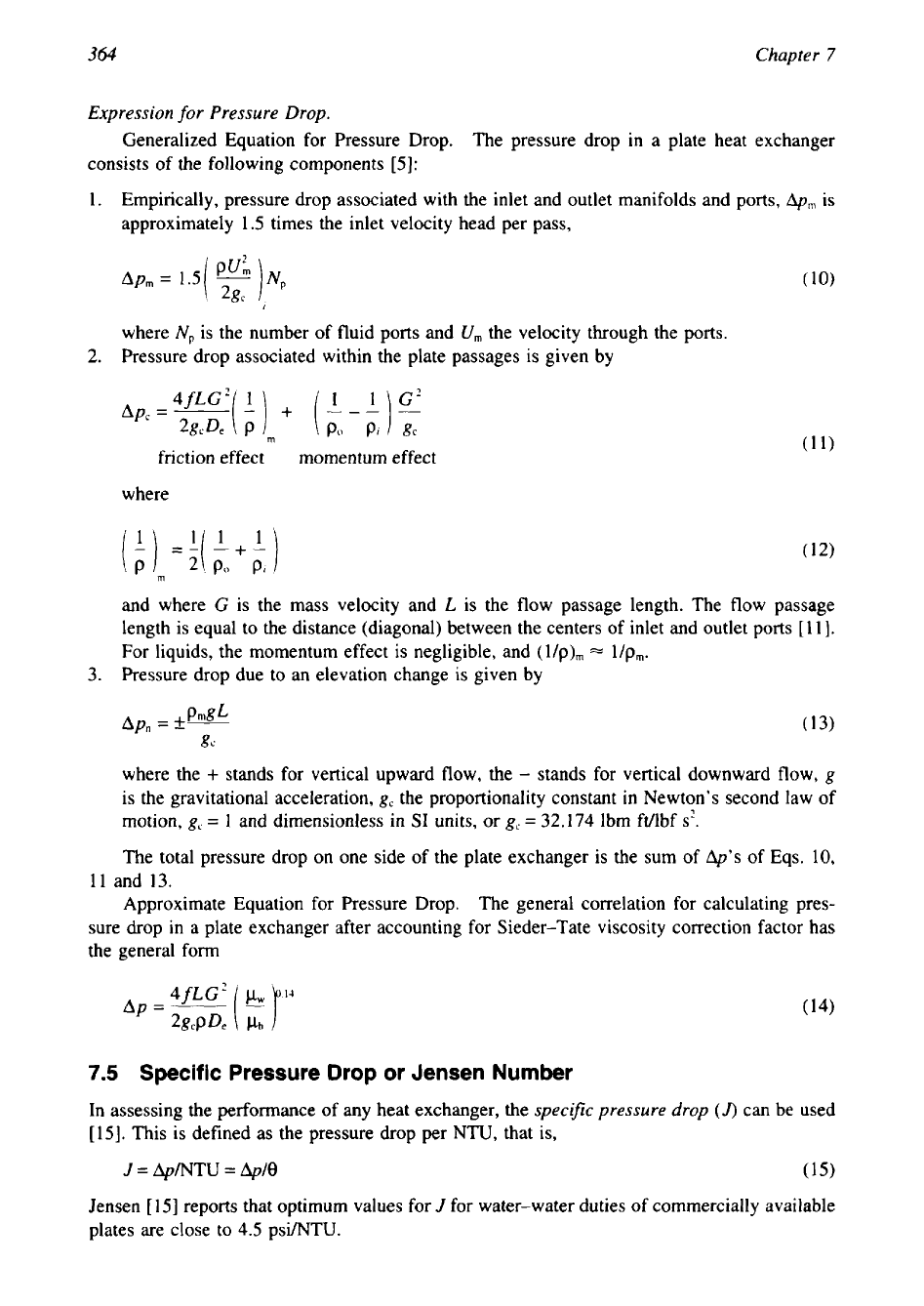
364
Chapter
7
Expression
for
Pressure Drop.
Generalized Equation for Pressure Drop.
The pressure drop in a plate heat exchanger
consists of the following components
[5]:
1.
Empirically, pressure drop associated with the inlet and outlet manifolds and ports,
Apm
is
approximately
1.5
times the inlet velocity head per pass,
where
Np
is the number of fluid ports and
U,,,
the velocity through the ports.
2.
Pressure drop associated within the plate passages is given by
Apt=--(-]
+
[?-’)”’
4fLG’
1
PO
2gcDe
P
PI
gc
friction effect momentum effect
where
and where
G
is the mass velocity and
L
is the flow passage length. The flow passage
length is equal to the distance (diagonal) between the centers of inlet and outlet ports
[
1
I].
For liquids, the momentum effect is negligible, and
(
==
Uprn.
3.
Pressure drop due to an elevation change is given by
where the
+
stands for vertical upward flow, the
-
stands for vertical downward flow,
g
is the gravitational acceleration,
g,
the proportionality constant in Newton’s second law of
motion,
g,
=
1
and dimensionless in SI units, or
g,
=
32.174
Ibm ft/lbf
s’.
The total pressure drop on one side of the plate exchanger is the sum of
Ap’s
of Eqs.
10,
11
and
13.
Approximate Equation for Pressure Drop. The general correlation for calculating pres-
sure drop in a plate exchanger after accounting for Sieder-Tate viscosity correction factor has
the general form
7.5
Specific Pressure Drop or Jensen Number
In assessing the performance of any heat exchanger, the
specific pressure drop
(J)
can be used
[15].
This is defined as the pressure drop per
NTU,
that is,
J
=
ApMTU
=
Aple
(15)
Jensen
[
151
reports that optimum values for
J
for water-water duties of commercially available
plates are close to
4.5
psi/NTU.
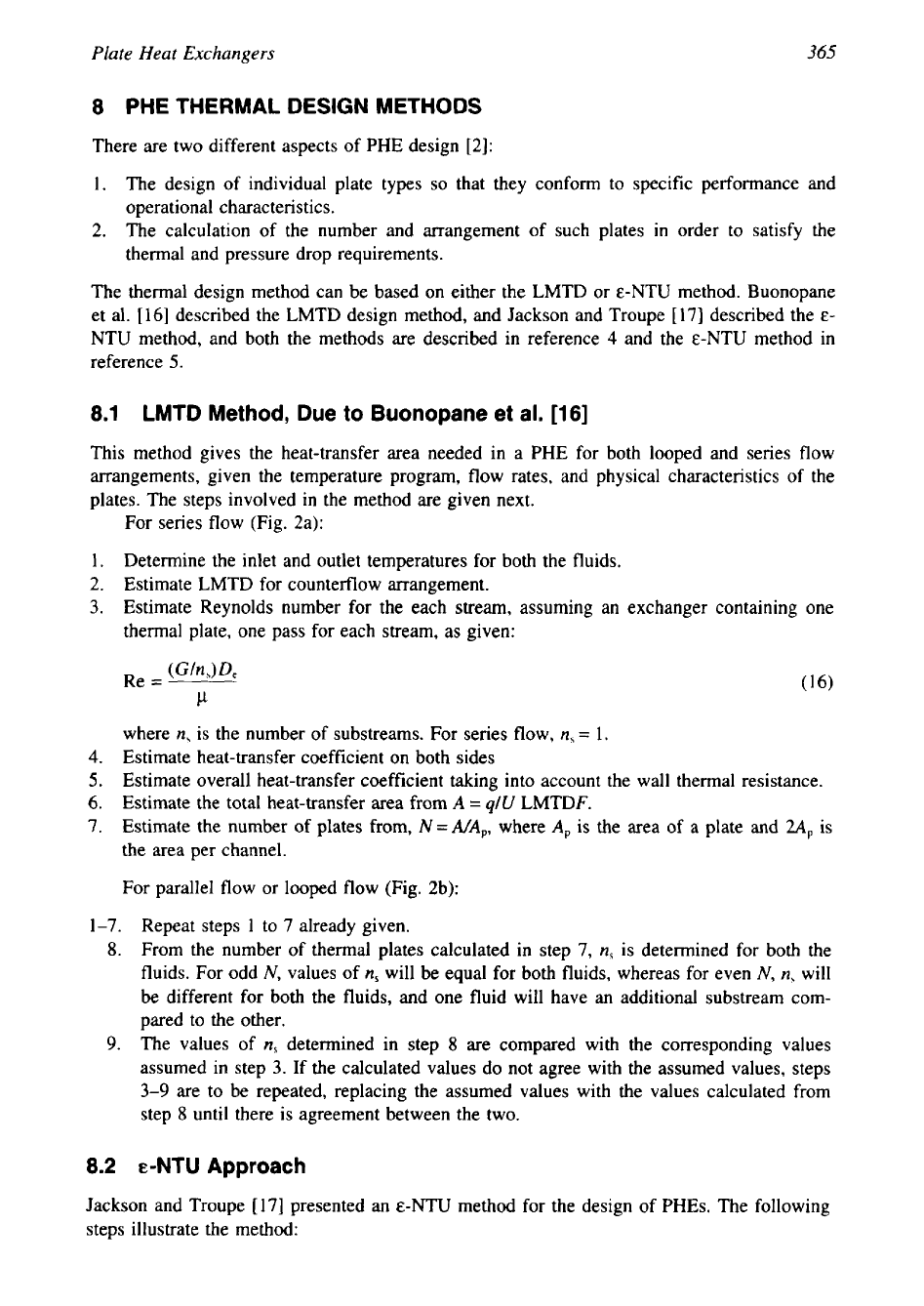
Plate Heat Exchangers
365
8 PHE THERMAL DESIGN METHODS
There are two different aspects of PHE design [2]:
1. The design of individual plate types
so
that they conform to specific performance and
operational characteristics.
2.
The calculation of the number and arrangement of such plates in order to satisfy the
thermal and pressure drop requirements.
The thermal design method can be based on either the LMTD or E-NTU method. Buonopane
et al.
[
161 described the LMTD design method, and Jackson and Troupe
[
171 described the
E-
NTU method, and both the methods are described in reference
4
and the E-NTU method in
reference
5.
8.1 LMTD Method, Due to Buonopane et
al.
[16]
This method gives the heat-transfer area needed in a PHE for both looped and series flow
arrangements, given the temperature program, flow rates, and physical characteristics of the
plates. The steps involved in the method are given next.
For series flow (Fig. 2a):
1.
Determine the inlet and outlet temperatures for both the fluids.
2.
Estimate LMTD for counterflow arrangement.
3.
Estimate Reynolds number for the each stream, assuming an exchanger containing one
thermal plate, one pass for each stream, as given:
where
n,
is the number of substreams. For series flow,
n,
=
1.
4.
Estimate heat-transfer coefficient on both sides
5.
Estimate overall heat-transfer coefficient taking into account the wall thermal resistance.
6.
Estimate the total heat-transfer area from
A
=
q/U
LMTDF.
7.
Estimate the number of plates
from,
N=A/A,,
where
A,
is the area of a plate and
U,
is
the area per channel.
For parallel flow or looped flow (Fig. 2b):
1-7.
Repeat steps 1 to 7 already given.
8.
From the number of thermal plates calculated in step 7,
n,
is determined for both the
fluids. For odd
N,
values of
n,
will be equal for both fluids, whereas for even
N,
n,
will
be different for both the fluids, and one fluid will have an additional substream com-
pared to the other.
9.
The values of
n,
determined in step
8
are compared with the corresponding values
assumed in step
3.
If the calculated values do not agree with the assumed values, steps
3-9
are to be repeated, replacing the assumed values with the values calculated from
step
8
until there is agreement between the two.
8.2 E-NTU Approach
Jackson and Troupe [17] presented an E-NTU method for the design of PHEs. The following
steps illustrate the method:

366
Chapter
7
1.
Calculate the heat load,
q,
and from it determine the inlet and outlet temperatures for both
the fluids.
2.
Calculate the bulk mean temperature and determine the thermo physical fluid properties.
Estimate the heat capacity rate ratio,
C*.
3.
Estimate the heat-transfer effectiveness,
E,
using the relation
4.
Assume an exchanger containing an infinite number of channels and find the required
NTU using the appropriate E-NTU relation.
5.
Estimate Reynolds number for the each stream, assuming an exchanger containing one
thermal plate, and one pass for each stream.
6.
Calculate the heat-transfer coefficient on both sides. Estimate the overall heat-transfer
coefficient, taking into account the wall thermal resistance.
For series flow (Fig. 2a):
7.
Estimate the approximate number of thermal plates using the equation
where
At,,,
is the mean temperature difference.
8.
Assuming an exchanger of
N+
1 channels, determine NTU from the appropriate E-NTU
relationship.
9.
Recalculate
N
from Eq. 18.
10.
Repeat calculations in steps 8 and
9
until the calculated value of
N
in step
9
matches the
assumed value in step 8.
For
parallel flow or looped flow (Fig.
2b):
In a design involving looped flow patterns, the
overall coefficient requires recalculation during each iteration because the channel flow rates
become less with the addition of channels in parallel. The calculation procedure for looped
flow
is
as follows:
7.
Assuming
an
exchanger of
N
thermal plates, calculate the overall heat-transfer coefficient
as in step
6.
8. Estimate the approximate number of thermal plates using Eq. 18.
9.
Assuming an exchanger of
N+
1 channels, determine NTU from the appropriate
E-NTU
relationship for looped flow.
10.
Recalculate the overall heat-transfer coefficient as per step
6
and recalculate
N
with
Eq.
18.
11.
Repeat calculations in steps
9
and 10 until the calculated value of
N
matches with the
assumed value.
8.3
Specification
Sheet
for
PHE
Table
6
is a specification sheet for
PHE.
9
CORROSION
OF
PLATE HEAT EXCHANGERS
It is general practice for plate exchanger manufacturers to use only corrosion-resistant materials
for a PHE, dictated by factors such as product purity and to minimize corrosion fouling. Ero-
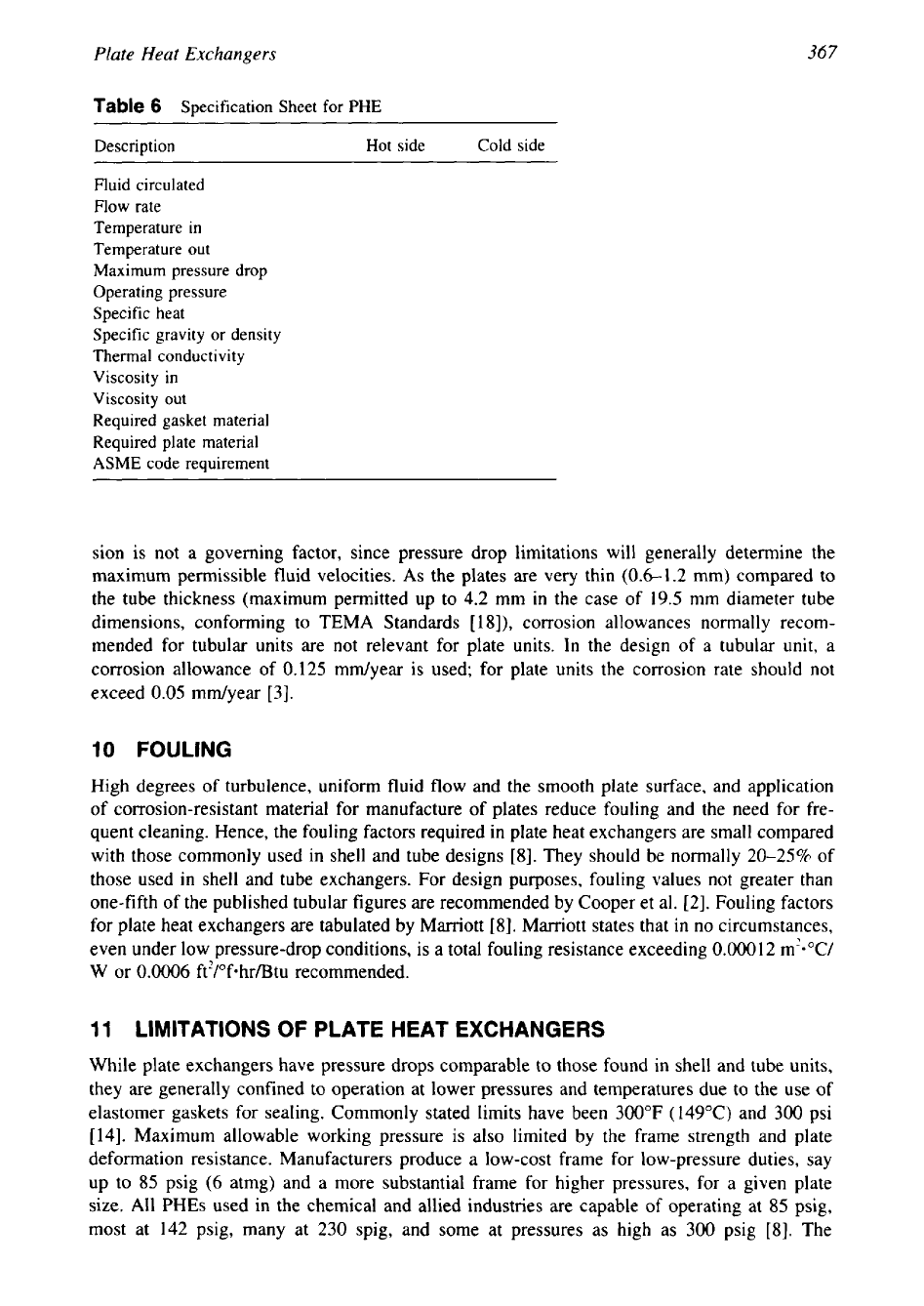
Plate Heat Exchangers
367
Table
6
Specification Sheet for PHE
Description
Hot
side Cold side
Fluid circulated
Flow rate
Temperature in
Temperature out
Maximum pressure drop
Operating pressure
Specific heat
Specific gravity
or
density
Thermal conductivity
Viscosity in
Viscosity out
Required gasket material
Required plate material
ASME code requirement
sion is not a governing factor, since pressure drop limitations will generally determine the
maximum permissible fluid velocities. As the plates are very thin (0.6-1.2 mm) compared to
the tube thickness (maximum permitted up to
4.2
mm
in
the case of
19.5
mm diameter tube
dimensions, conforming to TEMA Standards
[
1
S]),
corrosion allowances normally recom-
mended for tubular units are not relevant for plate units. In the design of a tubular unit, a
corrosion allowance of
0.125
mdyear
is
used; for plate units the corrosion rate should not
exceed
0.05
mdyear
[3].
10
FOULING
High degrees
of
turbulence, uniform fluid flow and the smooth plate surface, and application
of corrosion-resistant material for manufacture of plates reduce fouling and the need for fre-
quent cleaning. Hence, the fouling factors required in plate heat exchangers are small compared
with those commonly used in shell and tube designs
[8].
They should be normally
20-25%
of
those used in shell and tube exchangers. For design purposes, fouling values not greater than
one-fifth of the published tubular figures are recommended by Cooper et al.
[2].
Fouling factors
for plate heat exchangers are tabulated by Marriott
[8].
Marriott states that
in
no circumstances,
even under low pressure-drop conditions, is a total fouling resistance exceeding
0.000
12
m'*"C/
W
or
0.0006
fe/"f=hr/Btu recommended.
11
LIMITATIONS
OF
PLATE HEAT EXCHANGERS
While plate exchangers have pressure drops comparable to those found in shell and tube units,
they are generally confined to operation at lower pressures and temperatures due to the use of
elastomer gaskets for sealing. Commonly stated limits have been
300°F
(149°C)
and
300
psi
[14].
Maximum allowable working pressure is also limited by the frame strength and plate
deformation resistance. Manufacturers produce a low-cost frame for low-pressure duties, say
up to
85
psig
(6
atmg) and a more substantial frame for higher pressures, for a given plate
size. All
PHEs
used in the chemical and allied industries are capable of operating at
85
psig,
most at
142
psig, many at
230
spig, and some at pressures as high as
300
psig
[8].
The
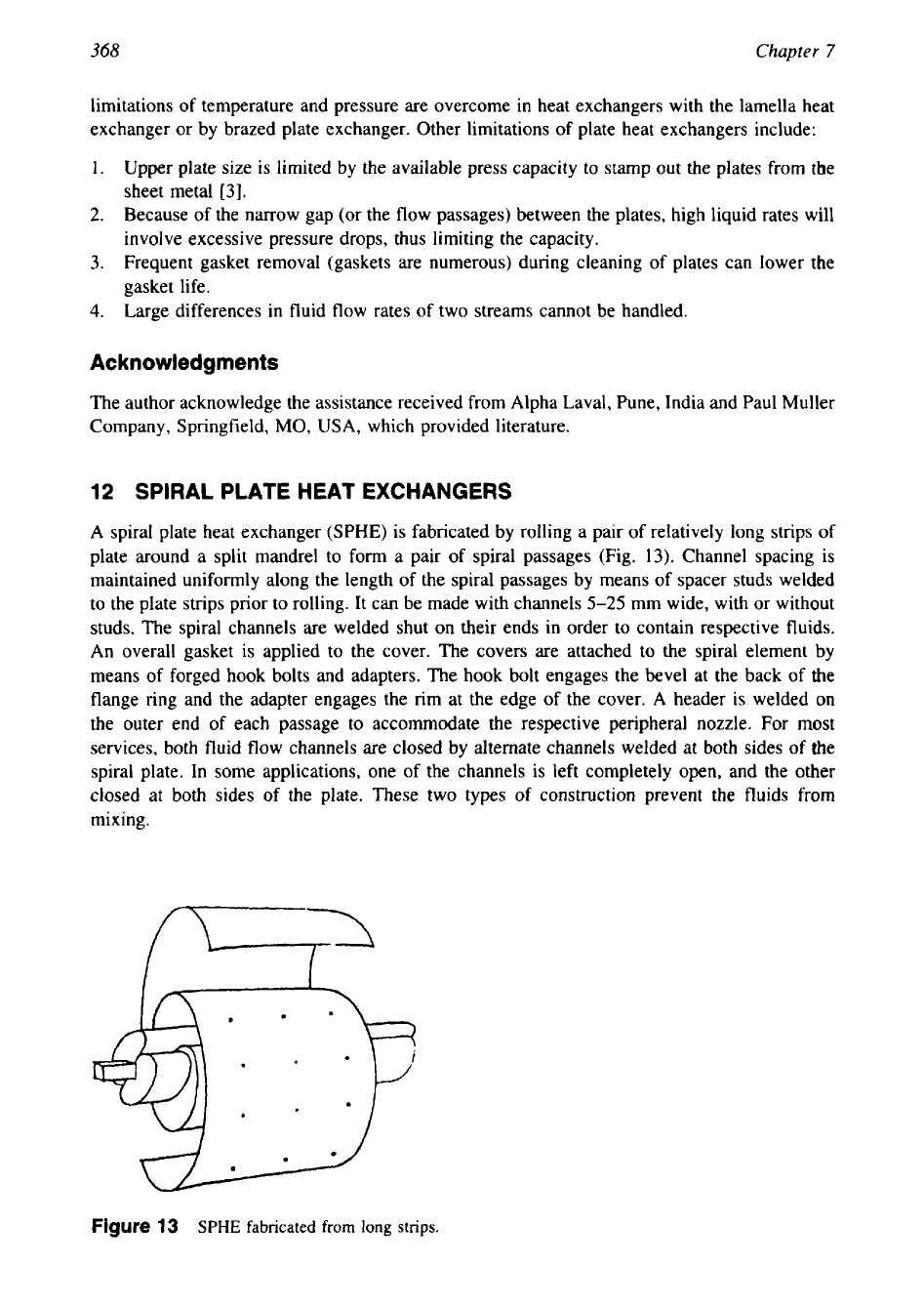
368
Chapter
7
limitations of temperature and pressure are overcome in heat exchangers with the lamella heat
exchanger or by brazed plate exchanger. Other limitations of plate heat exchangers include:
1.
Upper plate size is limited by the available press capacity to stamp out the plates from the
sheet metal
[3].
2.
Because of the narrow gap (or the flow passages) between the plates, high liquid rates will
involve excessive pressure drops, thus limiting the capacity.
3.
Frequent gasket removal (gaskets are numerous) during cleaning of plates can lower the
gasket life.
4.
Large differences in fluid flow rates of two streams cannot be handled.
Acknowledgments
The author acknowledge the assistance received from Alpha Laval, Pune, India and Paul Muller
Company, Springfield, MO, USA, which provided literature.
12
SPIRAL PLATE HEAT EXCHANGERS
A spiral plate heat exchanger
(SPHE)
is fabricated by rolling a pair of relatively long strips of
plate around a split mandrel to form a pair of spiral passages (Fig.
13).
Channel spacing is
maintained uniformly along the length
of
the spiral passages by means
of
spacer studs welded
to the plate strips prior to rolling. It can be made with channels
5-25
mm wide, with or without
studs. The spiral channels are welded shut on their ends in order to contain respective fluids.
An overall gasket is applied to the cover. The covers are attached to the spiral element by
means of forged hook bolts and adapters. The hook bolt engages the bevel at the back
of
the
flange ring and the adapter engages the rim at the edge of the cover.
A
header is welded on
the outer end of each passage to accommodate the respective peripheral nozzle. For most
services, both fluid flow channels are closed by alternate channels welded at both sides
of
the
spiral plate. In some applications, one
of
the channels is left completely open, and the
other
closed at
both
sides of the plate. These two types of construction prevent the fluids from
mixing
.
Figure
13
SPHE
fabricated
from
long
strips.
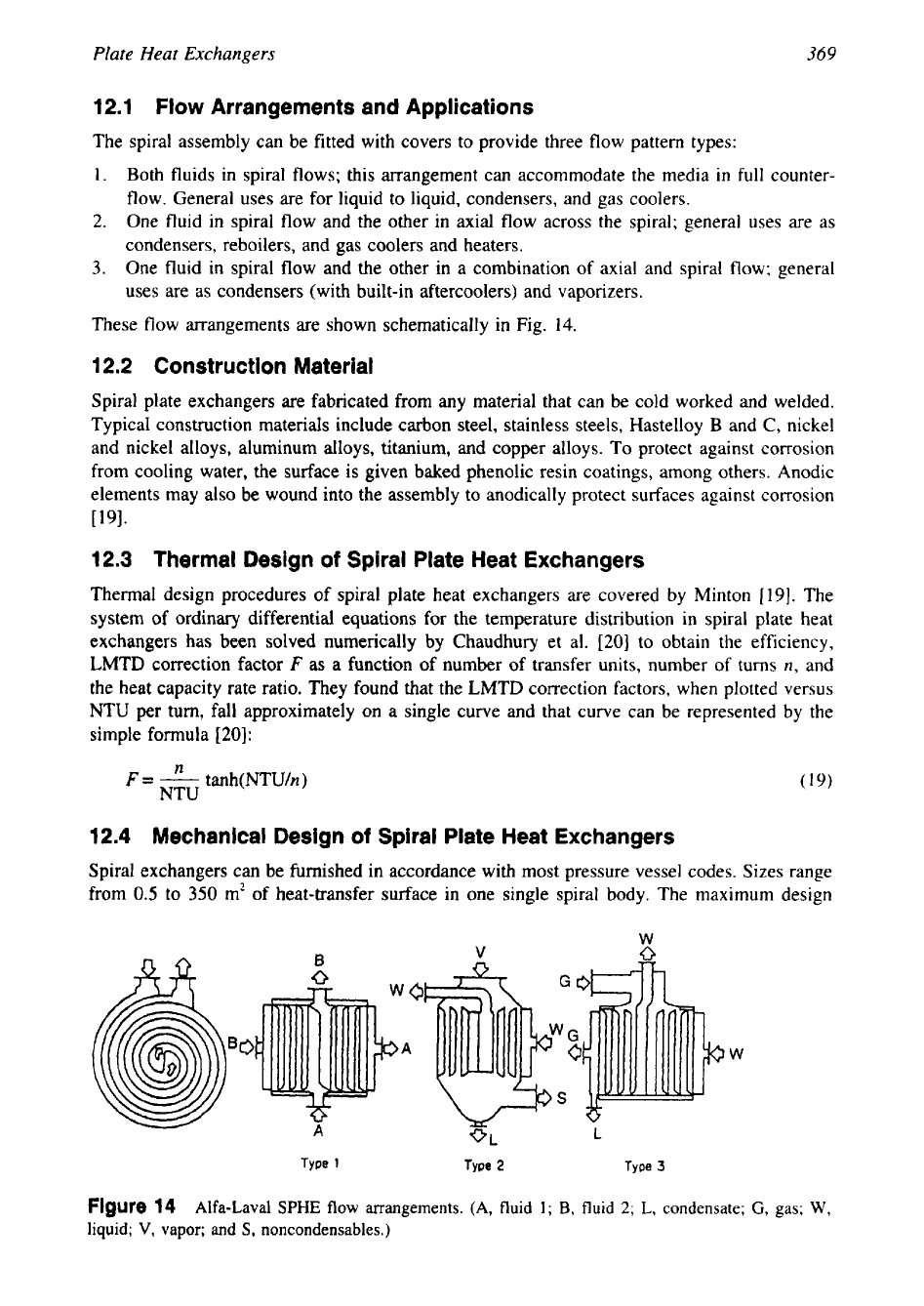
Plate Heat Exchangers
369
12.1
Flow
Arrangements and Applications
The spiral assembly can be fitted with covers to provide three flow pattern types:
1.
Both fluids in spiral flows; this arrangement can accommodate the media in
full
counter-
flow. General uses are for liquid to liquid, condensers, and gas coolers.
2.
One fluid in spiral flow and the other in axial flow across the spiral; general uses are as
condensers, reboilers, and gas coolers and heaters.
3.
One fluid in spiral flow and the other in a combination of axial and spiral flow; general
uses are as condensers (with built-in aftercoolers) and vaporizers.
These flow arrangements are shown schematically in Fig.
14.
12.2 Construction Material
Spiral plate exchangers are fabricated from any material that can be cold worked and welded.
Typical construction materials include carbon steel, stainless steels, Hastelloy
B
and
C,
nickel
and nickel alloys, aluminum alloys, titanium, and copper alloys. To protect against corrosion
from cooling water, the surface is given baked phenolic resin coatings, among others. Anodic
elements may also be wound into the assembly to anodically protect surfaces against corrosion
~91.
12.3
Thermal
Design
of
Spiral Plate Heat Exchangers
Thermal design procedures of spiral plate heat exchangers are covered by Minton
[19].
The
system of ordinary differential equations for the temperature distribution in spiral plate heat
exchangers has been solved numerically by Chaudhury et al.
[20]
to obtain the efficiency,
LMTD
correction factor
F
as a function of number
of
transfer units, number of turns
n,
and
the heat capacity rate ratio. They found that the
LMTD
correction factors, when plotted versus
NTU per turn, fall approximately on a single curve and that curve can be represented by the
simple formula
[20]:
n
F=-
NTU
tan
h
(NTU/n
)
12.4
Mechanical Design
of
Spiral Plate Heat Exchangers
Spiral exchangers can be furnished in accordance with most pressure vessel codes. Sizes range
from
0.5
to
350
m2 of heat-transfer surface in one single spiral body. The maximum design
Figure
14
Alfa-Laval
SPHE
flow
arrangements. (A, fluid
1;
B,
fluid
2;
L,
condensate;
G,
gas;
W,
liquid;
V,
vapor; and S, noncondensables.)
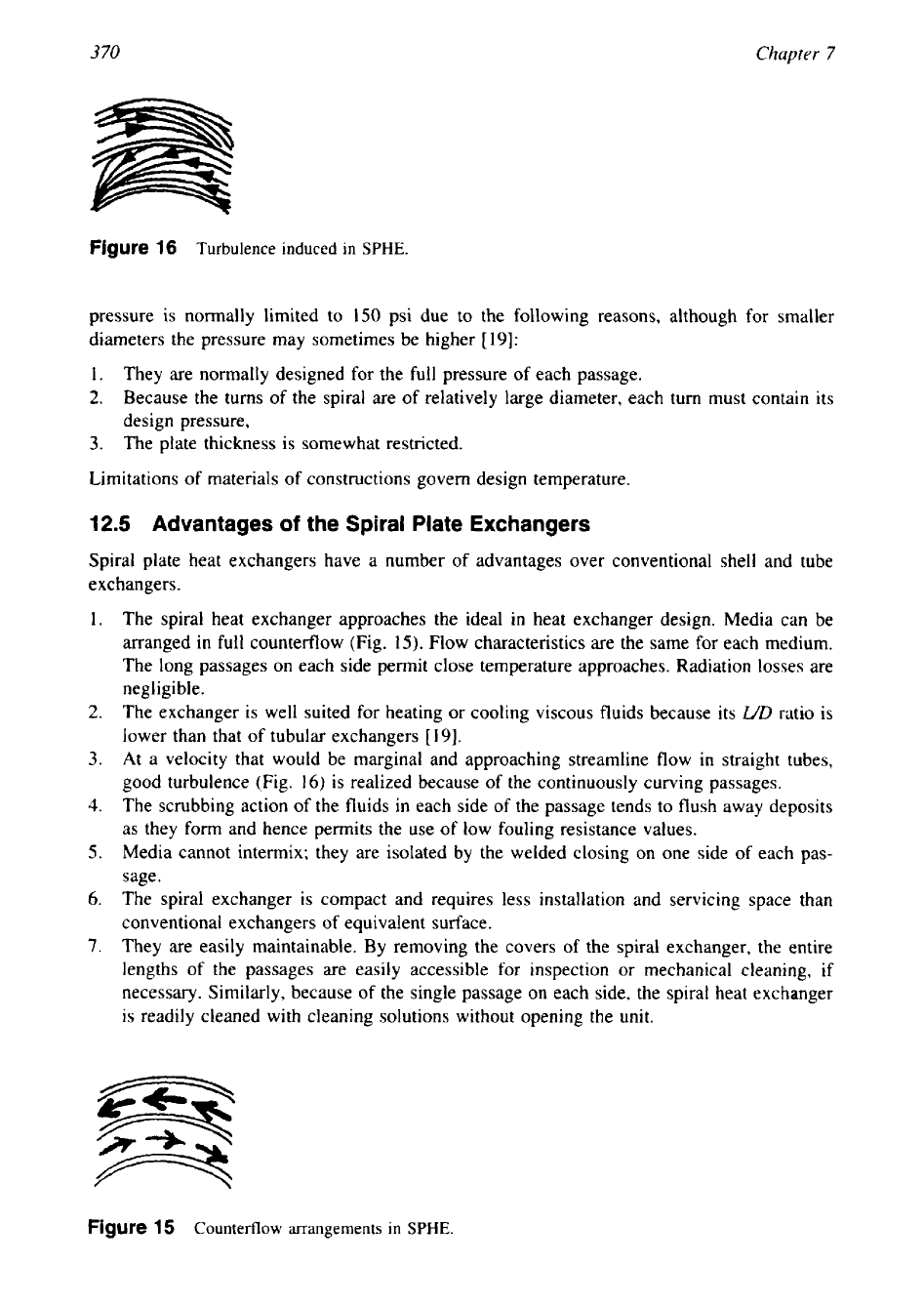
3
70
Chapter
7
Figure
16
Turbulence
induced
in
SPHE.
pressure is normally limited to
150
psi due to the following reasons, although for smaller
diameters the pressure may sometimes be higher [19]:
1.
They are normally designed for the full pressure of each passage.
2.
Because the turns of the spiral are of relatively large diameter, each
turn
must contain its
design pressure,
3.
The plate thickness is somewhat restricted.
Limitations of materials of constructions govern design temperature.
12.5
Advantages
of
the Spiral Plate Exchangers
Spiral plate heat exchangers have a number
of
advantages over conventional shell and tube
exchangers.
1.
The spiral heat exchanger approaches the ideal in heat exchanger design. Media can be
arranged in full counterflow (Fig. 15). Flow characteristics are the same for each medium.
The long passages on each side permit close temperature approaches. Radiation losses are
negligible.
2.
The exchanger is well suited for heating or cooling viscous fluids because its
UD
ratio is
lower than that of tubular exchangers
[
191.
3.
At a velocity that would be marginal and approaching streamline flow
in
straight tubes,
good turbulence (Fig. 16) is realized because of the continuously curving passages.
4.
The scrubbing action
of
the fluids
in
each side
of
the passage tends to flush away deposits
as
they form and hence permits the use
of
low fouling resistance values.
5.
Media cannot intermix; they are isolated by the welded closing on one side of each pas-
sage.
6.
The spiral exchanger is compact and requires less installation and servicing space than
conventional exchangers of equivalent surface.
7.
They are easily maintainable. By removing the covers of the spiral exchanger, the entire
lengths
of
the passages are easily accessible for inspection or mechanical cleaning, if
necessary. Similarly, because of the single passage on each side, the spiral heat exchanger
is readily cleaned with cleaning solutions without opening the unit.
Figure
15
Counterflow arrangements in
SPHE.
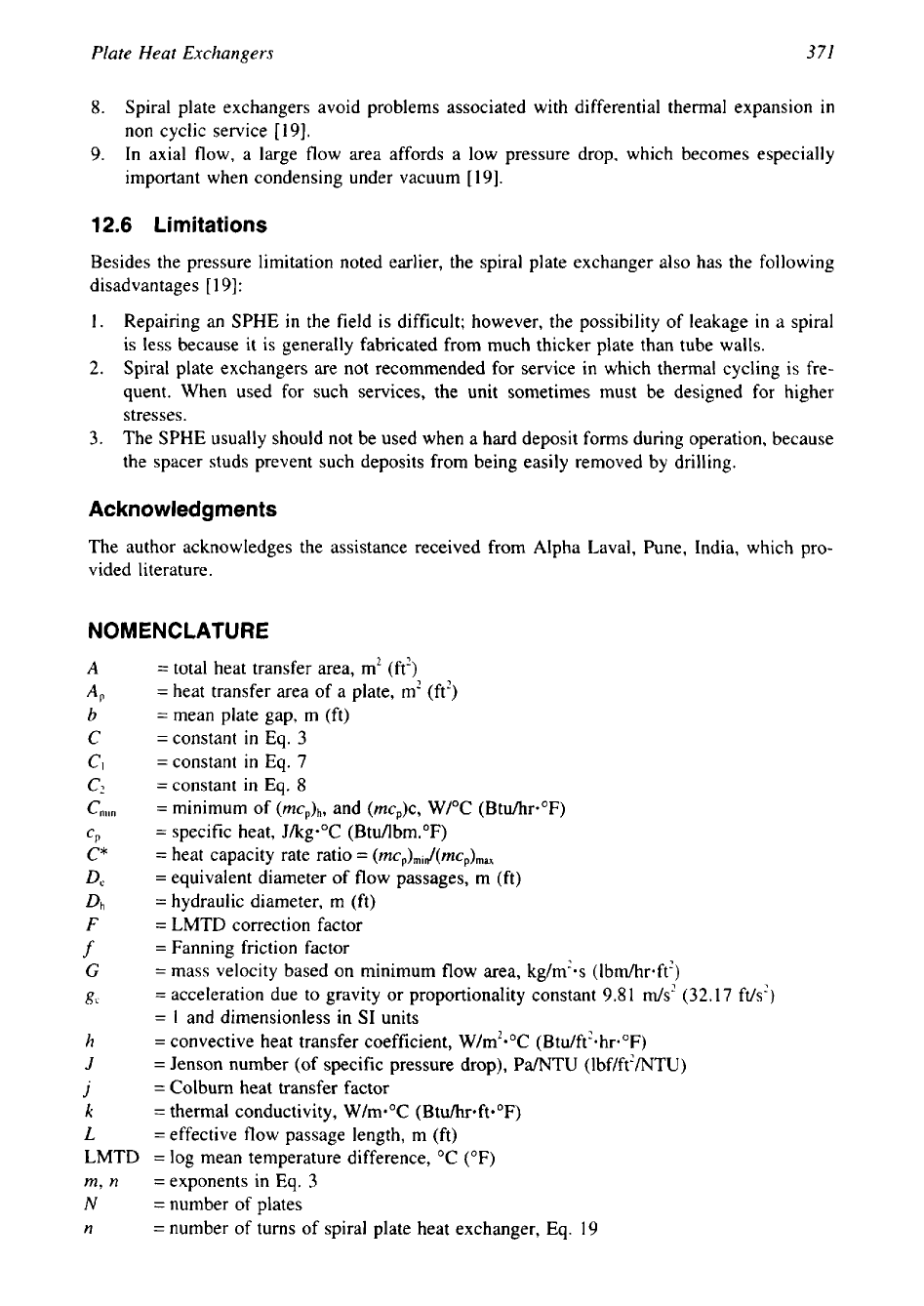
Plate Heat Exchangers
3
71
8.
Spiral plate exchangers avoid problems associated with differential thermal expansion
in
non cyclic service [19].
9. In axial flow, a large flow area affords a low pressure drop, which becomes especially
important when condensing under vacuum
[
191.
12.6
Limitations
Besides the pressure limitation noted earlier, the spiral plate exchanger also has the following
disadvantages
[
191:
1.
Repairing an SPHE in the field is difficult; however, the possibility of leakage in a spiral
is less because it is generally fabricated from much thicker plate than tube walls.
2. Spiral plate exchangers are not recommended for service in which thermal cycling is fre-
quent. When used for such services, the unit sometimes must be designed for higher
stresses.
3. The SPHE usually should not be used when a hard deposit forms during operation, because
the spacer studs prevent such deposits from being easily removed by drilling.
Acknowledgments
The author acknowledges the assistance received from Alpha Laval, Pune, India, which pro-
v
ided literature
.
NOMENCLATURE
A
=
total heat transfer area, m2 (ft')
AP
=
heat transfer area of a plate, m2 (ft')
b
=
mean plate gap, m (ft)
C
=constant in Eq.
3
CI
=constant
in
Eq. 7
c2
=constant
in
Eq.
8
C",
=
minimum of
(mep),,,
and (mc,)c, W/"C (Btu/hr*"F)
I
n
=
specific heat, J/kg*"C (Btu/lbm."F)
CP
C"
=
heat capacity rate ratio
=
(m~~)~~~/(m~~)~~~
Dc
=
equivalent diameter of flow passages, m (ft)
Dh
=
hydraulic diameter, m (ft)
F
=
LMTD correction factor
f
=
Fanning friction factor
G
=
mass velocity based on minimum flow area, kg/m'*s (lbm/hr*ft?)
gc
=
acceleration due to gravity or proportionality constant 9.8 1
m/s2
(32.17 ft/s2)
=
1
and dimensionless in
SI
units
h
=
convective heat transfer coefficient, W/m2eoC (Btu/ft?*hr*"F)
J
=
Jenson number (of specific pressure drop), Pa/NTU (lbf/ft'/NTU)
j
=
Colburn heat transfer factor
k
=
thermal conductivity, W/m*"C (Btu/hr*ft*"F)
L
=
effective flow passage length, m (ft)
LMTD
=
log mean temperature difference,
"C
(OF)
m,
n
=
exponents in Eq.
3
N
=
number of plates
n
=
number of turns of spiral plate heat exchanger, Eq. 19
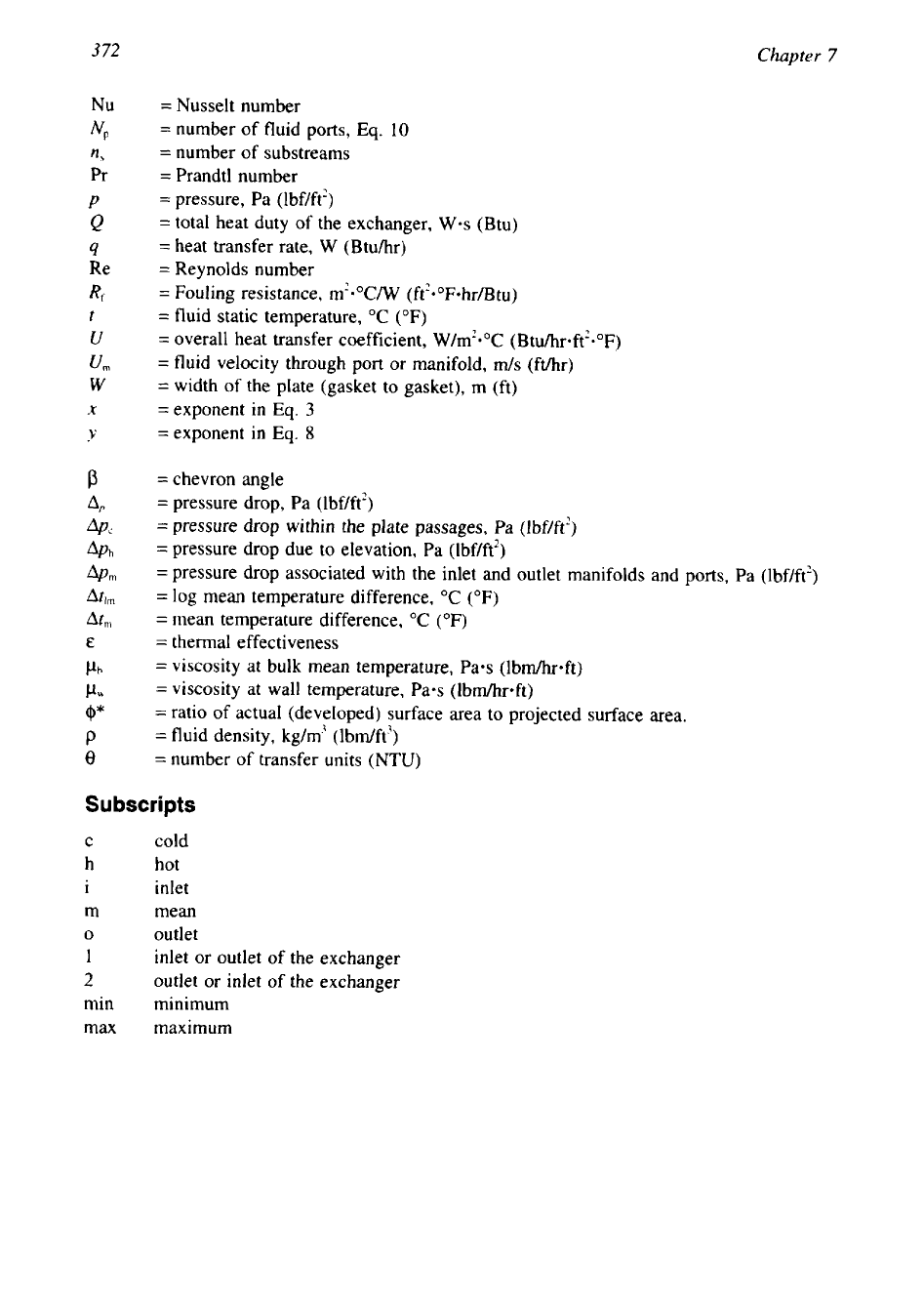
Chapter
7
=
Nusselt number
=
number of fluid ports,
Eq.
10
=
number of substreams
=
Prandtl number
=
pressure, Pa (lbflft?)
=
total heat duty of the exchanger,
W*s
(Btu)
=
heat transfer rate,
W
(Btuhr)
=
Reynolds number
=
Fouling resistance, m'*"C/W (ft'*"F*hr/Btu)
=
fluid static temperature,
"C
(OF)
=
overall heat transfer coefficient, W/m'*"C (Btu/hr*ft?*"F)
=
fluid velocity through
port
or manifold,
m/s
(far)
=
width of the plate (gasket to gasket), m (ft)
=exponent in
Eq.
3
=exponent in
Eq.
8
=
chevron angle
=
pressure drop, Pa (lbf/ft')
=
pressure drop within the plate passages, Pa (Ibf/ft')
=
pressure
drop
due to elevation, Pa (lbf/ft2)
=pressure
drop
associated with the inlet and outlet manifolds and ports, Pa (Ibf/ft')
=
log mean temperature difference,
"C
(OF)
=
mean temperature difference, "C
(OF)
=
thermal effectiveness
=
viscosity at bulk mean temperature, Pa-s (lbm/hr*ft)
=
viscosity at wall temperature, Pa-s (lbm/hr.ft)
=
ratio
of
actual (developed) surface area to projected surface area.
=
fluid density, kg/m' (lbdft3)
=
number
of
transfer units (NTU)
Subscripts
C
cold
h hot
i
inlet
m mean
0
outlet
1
inlet or outlet of the exchanger
2
outlet or inlet of the exchanger
min minimum
max maximum
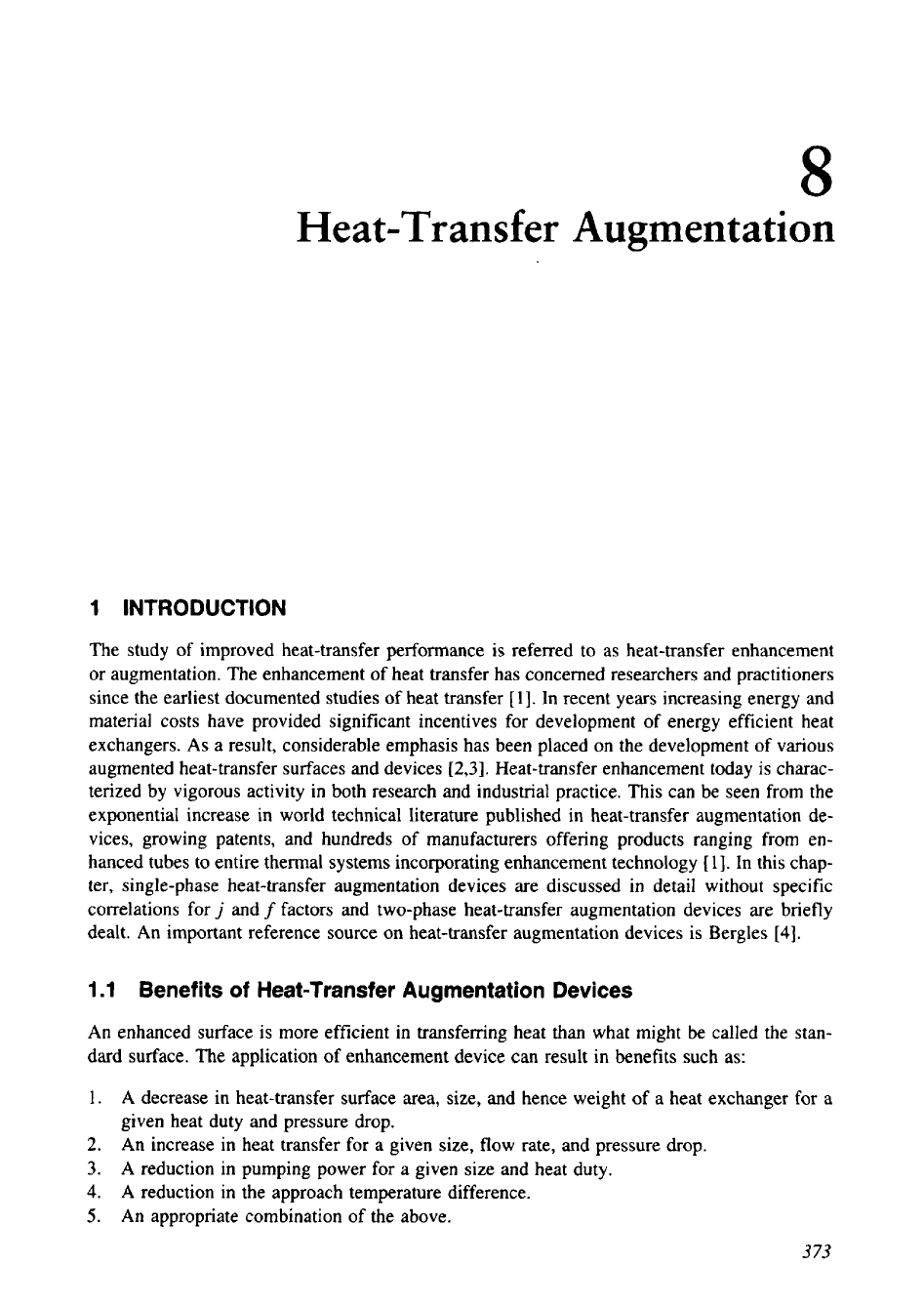
Heat-Transfer Augmentation
1
INTRODUCTION
The study of improved heat-transfer performance is referred to as heat-transfer enhancement
or augmentation. The enhancement of heat transfer has concerned researchers and practitioners
since the earliest documented studies of heat transfer
[
11. In recent years increasing energy and
material costs have provided significant incentives for development of energy efficient heat
exchangers. As a result, considerable emphasis has been placed on the development of various
augmented heat-transfer surfaces and devices
[2,3].
Heat-transfer enhancement today is charac-
terized by vigorous activity in both research and industrial practice. This can be seen from the
exponential increase in world technical literature published in heat-transfer augmentation de-
vices, growing patents, and hundreds of manufacturers offering products ranging from en-
hanced tubes to entire thermal systems incorporating enhancement technology
[
11. In this chap-
ter, single-phase heat-transfer augmentation devices are discussed in detail without specific
correlations for
j
and
f
factors and two-phase heat-transfer augmentation devices are briefly
dealt. An important reference source on heat-transfer augmentation devices is Bergles [4].
1.1
Benefits of Heat-Transfer Augmentation Devices
An enhanced surface
is
more efficient in transferring heat than what might be called the stan-
dard surface. The application of enhancement device can result in benefits such as:
1. A decrease in heat-transfer surface area, size, and hence weight of a heat exchanger for
a
given heat duty and pressure drop.
2.
An increase in heat transfer for a given size, flow rate, and pressure drop.
3.
A reduction in pumping power for a given size and heat duty.
4.
A reduction in the approach temperature difference.
5.
An appropriate combination of the above.
373
